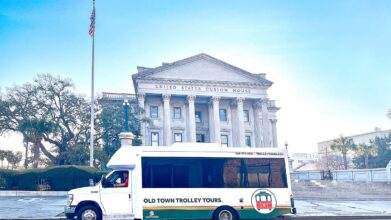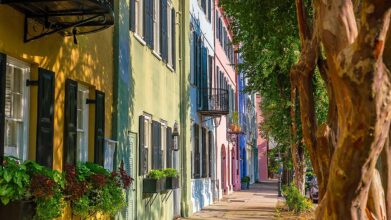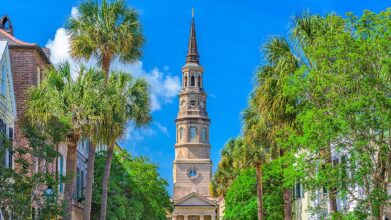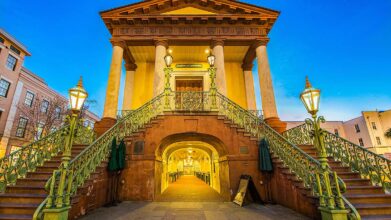Rainbow Row
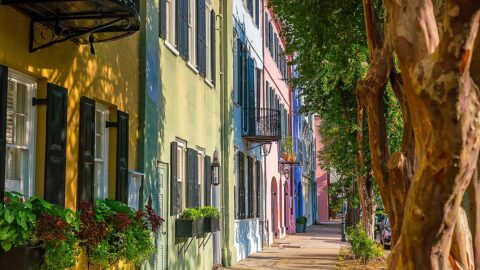
Rainbow Row is one of Charleston’s most famous landmarks. These pastel-colored homes along East Bay Street were built in the 1700s and restored in the 1930s. Some say the bright colors helped sailors find their way home, while others believe it was simply a trend. The row has since become one of the most photographed spots in Charleston, drawing visitors from around the world.
History of Rainbow Row
The history of Rainbow Row dates back to the mid-18th century when the houses were built as merchant shops. Over the years, the buildings fell into disrepair after the Civil War. It wasn’t until the 1930s and ‘40s that they were restored and painted in the vibrant colors we see today. These colors weren’t chosen randomly; they were based on Caribbean traditions and helped keep the houses cool and recognizable to sailors.
Know Before You Go
Getting Around: Exploring the charm of Rainbow Row is best done at a leisurely pace, making walking the ideal way to experience its unique character. This stretch of East Bay Street, with its 13 brightly colored historic houses standing shoulder to shoulder, is relatively compact and pedestrian-friendly.
Parking: There is no public parking directly on the block of Rainbow Row. This pedestrian-friendly stretch of East Bay Street, between Tradd and Elliott Streets, is best accessed by parking in a nearby garage or finding street parking in the surrounding area. The closest public parking garage is the East Bay/Prioleau Parking Garage, located just a couple of blocks north on East Bay Street.
Best Time To Visit for Photos: To capture the most stunning photographs of Rainbow Row’s charming pastel facades, timing is key. For the best light and vibrant colors, plan your visit between May and July. During these months, aim to be there in the mid-morning to early afternoon, specifically around 11 am to 1 pm. This is when the sun is positioned to directly illuminate the row of historic buildings, washing them in a beautiful light that truly brings out their unique hues for picture-perfect moments.
Houses of Rainbow Row
Tradd Street House: Nos. 79-81
79-81 is a two-part building located at the southernmost tip of Rainbow Row. The building consists of two separate structures: the southernmost building dates from around 1845, making it the newest structure on Rainbow Row, while the adjoining building at 81 East Bay Street was built after a fire in 1778 and before 1785. Together, they form a distinctive architectural landmark that anchors this vibrant area.
William Stone House: No. 83
The William Stone House was built around 1784 by a Tory merchant who later left Charleston during the American Revolutionary War. This historic house has experienced only minor restorations over the years, preserving much of its original character. In 1941, Susan Pringle Frost restored the house, adding a neoclassical balcony to the front and replacing a storefront with a Colonial Revival-style door. The house features a beautiful floor plan with a large dining room and solarium overlooking a garden designed by Loutrel Briggs in 1939. The second-floor drawing room is particularly attractive, with jib doors opening onto the balcony.
James Gordon House: No. 87
James Gordon House is a testament to Charleston’s enduring spirit. Originally built around 1778, the structure at No. 87 East Bay Street met an unfortunate fate, succumbing to fire. However, in 1792, a Scottish merchant named James Gordon resurrected the site, leaving his mark on this now iconic street. Fast-forward to the 1920s. The house found a new chapter under the ownership of Susan Pringle. Today, the James Gordon House greets visitors with a cheerful yellow facade, a sunny spot within the colorful spectrum of Rainbow Row, embodying both its historical resilience and vibrant present.
Deas-Tunno House: No. 89
The Deas-Tunno House, standing proudly at No. 89 Rainbow Row, offers a fascinating glimpse into Charleston’s layered past. Constructed around 1770, its initial purpose blended commerce and residence, with the owner conducting business on the lower floors while living above. This distinguished it from some of its neighbors. Adding to its unique character within the iconic row is the presence of a small charming side garden, a rare feature along this stretch. Furthermore, the property extends beyond the main house to include extensive outbuildings. These structures served significant, albeit somber, roles in the past, functioning as both slave quarters and a warehouse, offering a tangible connection to the complex social and economic history of the era.
James Cook House: No. 93
The bright yellow facade of No. 93 marks the historic James Cook House, believed to have been built around 1778. This beautifully restored residence offers a glimpse into Charleston’s past. Step inside to discover a charming first floor, thoughtfully laid out with a welcoming kitchen and an inviting dining room, perfect for imagining life in centuries past. Ascend to the second floor and find an elegant drawing room, likely a space for receiving guests and socializing, alongside a distinguished library, hinting at the intellectual pursuits of its former inhabitants. The James Cook House stands as a vibrant testament to Charleston’s enduring architectural heritage.
Charles Cotesworth Pickney House: No. 95
The enigmatic No. 95 is a four-story pastel green residence shrouded in a touch of historical mystery. While its exact origins remain debated, architectural scholars note striking similarities to the designs of Othniel Beale, the craftsman behind the neighboring houses at Nos. 97 through 101. Adding to its historical significance, American Statesman Charles Cotesworth Pinckney, a prominent figure in the early years of the United States, owned this very property in 1779. Centuries later, in 1938, the house underwent a significant renovation under the ownership of New York Playwright John McGowan, breathing new life into its historic structure, which is distinguished by its characteristic Flemish gable roofline.
Othniel Beale/Dorothy Legge: No. 97
The property at No. 97 East Bay Street holds historical significance, as it was once purchased by Charles Othniel Beale, who further expanded his holdings by constructing the adjacent houses at numbers 99 and 101. These subsequent buildings, 99-101, were designed with architectural unity, sharing a roofline, a party wall, and cohesive decorative details. Decades later, in 1931, Judge Lionel Legge and his wife, Dorothy Legge, undertook the significant task of restoring the buildings at 99-101 East Bay Street, contributing to the preservation of this iconic stretch now known as Rainbow Row.
Joseph Dulles House: No. 103
The Joseph Dulles House, located at 103 East Bay Street in Charleston’s historic Rainbow Row, was built around 1787. This makes it one of the later additions to the row of houses that primarily date back to the mid-18th century. The house is named after Charles Joseph Dulles, an ancestor of John Foster Dulles, who served as the U.S. Secretary of State under President Dwight D. Eisenhower. Architecturally, the Joseph Dulles House reflects the Georgian style prevalent during its construction. However, like the other houses on Rainbow Row, it underwent significant restoration in the 1930s and 1940s. This period saw the application of the now iconic pastel colors to the facades, contributing to the “rainbow” effect of the street. The Joseph Dulles House is often noted for its distinctive purple color.
Dutarque-Guida House: No. 105
The Charles Dutarque-Guida House, located at 105 East Bay Street and a prominent fixture of Charleston’s Rainbow Row, boasts a rich and layered history. The property was initially acquired in 1778 by Lewis Dutarque, who promptly began construction on a house. This places its origins firmly within the late 18th century, aligning with the general time frame of the other historic homes that comprise the iconic street. A significant later owner of the property was Giovanni Domenico Guida, an Italian immigrant. Guida’s contribution to the house’s character is particularly notable as he added a Victorian iron storefront to the building.
John Blake House: No. 107
The house located at 107 East Bay Street, now a vibrant part of Charleston’s Rainbow Row, has a rich history dating back to its first purchase by John Blake in 1791. Blake was not only a prominent figure in Charleston as a Revolutionary War patriot but also served as a state senator, adding a layer of historical significance to the property. This outbuilding, a common feature in Charleston architecture of the period, served as the functional space for cooking and often housed enslaved individuals. Today, this kitchen house stands as a separate building, having been reoriented to face Elliot Street, further illustrating the evolving layout of the property and the surrounding area over time.
Nearby Things To Do
Waterfront Park
Waterfront Park, situated along the Cooper River in Charleston, is an 8 acre park that offers stunning views of the harbor. Once a bustling area of wharves and shipping terminals, it fell into decline after the Civil War, culminating in a devastating fire in 1955. Thanks to Mayor Joseph P. Riley Jr.’s vision, the area was transformed, and the park opened in 1990. Today, it features a pier, a large lawn, a distinctive pineapple fountain and walking paths, making it a popular destination for both locals and tourists.
French Quarter
The historic heart of Charleston, the French Quarter, stands as a captivating testament to the city’s rich and diverse past. This charming neighborhood, roughly bounded by Broad Street to the south, Meeting Street to the west, Market Street to the north and the Cooper River waterfront to the east, exudes a distinct European flair with its cobblestone streets, hidden alleyways, and beautifully preserved architecture.
The Battery
The Battery, a landmark defensive seawall and promenade in Charleston, offers stunning views of Charleston Harbor. Originally built for military purposes, it is now a popular spot for leisurely strolls, offering a glimpse into the city’s rich history with its preserved cannons and antebellum mansions lining the waterfront. The Battery is also known for its proximity to White Point Garden, a park that showcases historical monuments and offers further scenic views.
FAQs
How long do you need to visit Rainbow Row?
Allow for at least 30 minutes to an hour. This time frame provides enough opportunity to stroll along the block, admire the colorful facades, capture photographs and perhaps read the historical markers.
What is Rainbow Row in Charleston famous for?
Rainbow Row in Charleston is famous for its 13 historic houses painted in a vibrant spectrum of pastel colors. The picturesque and iconic East Bay Street is a popular tourist attraction, renowned for its unique visual appeal, offering a delightful glimpse into Charleston’s architectural heritage.
What are three interesting facts about Rainbow Row in Charleston?
The three interesting facts about Charleston’s Rainbow Row:
- Originally Merchant Shops: The 13 colorful houses that make up Rainbow Row were not always grand residences. They were initially built in the mid-18th century as commercial properties, housing shops and businesses along the bustling waterfront.
- Post-Civil War Neglect and Revival: After the Civil War, the area fell into disrepair and was considered a slum. It wasn’t until the 1930s and 1940s that a significant restoration project, spearheaded by Dorothy Porcher Legge, began the transformation of the dilapidated buildings into the charming, colorful homes we see today.
- Caribbean-Inspired Colors: The pastel hues that give Rainbow Row its name weren’t chosen arbitrarily. It’s believed the colors were inspired by Caribbean architectural traditions and were intended to not only be aesthetically pleasing but also to help keep the houses cooler in the warm climate and make them more easily identifiable from the sea.

